Deep in Galicia, devout Spaniards who have cheated death are paraded around in coffins to give thanks to God and to the miraculous sister of Lazarus.
About a year ago Karina Dominguez’s heart almost stopped. Midway through an operation something went wrong and her pulse plummeted to within a few sluggish beats of death. “They told me it went as low as it possibly could go without stopping all together,” she says stoically. “I won’t tell you why they operated on me. What is more important is that I survived and for that I must give thanks.”
Domínguez is a 28-year-old Spaniard from the town of Santa Marta de Ribarteme, in the province of Pontevedra, Galicia. She is a devout Catholic, a mother and believer in paying her dues. “I did it this year for my children and for me,” she says, obviously emotional, “to show gratitude for my own survival and so that the bump on my daughter’s chest might go away.” Although Karina demonstrates a great pride for her tradition she is aware of the reputation her particular version of gratitude has garnered. “Many people call us crazy for what we do,” she tells me, “but I call it faith.” To thank God for her survival for her own life and to pray for the recovery of her daughter, on the 29th of July this year, Karina got inside a coffin and, with thousands of people watching, she enacted her own funeral in the annual pilgrimage of La Romeria de Santa Marta de Ribarteme.
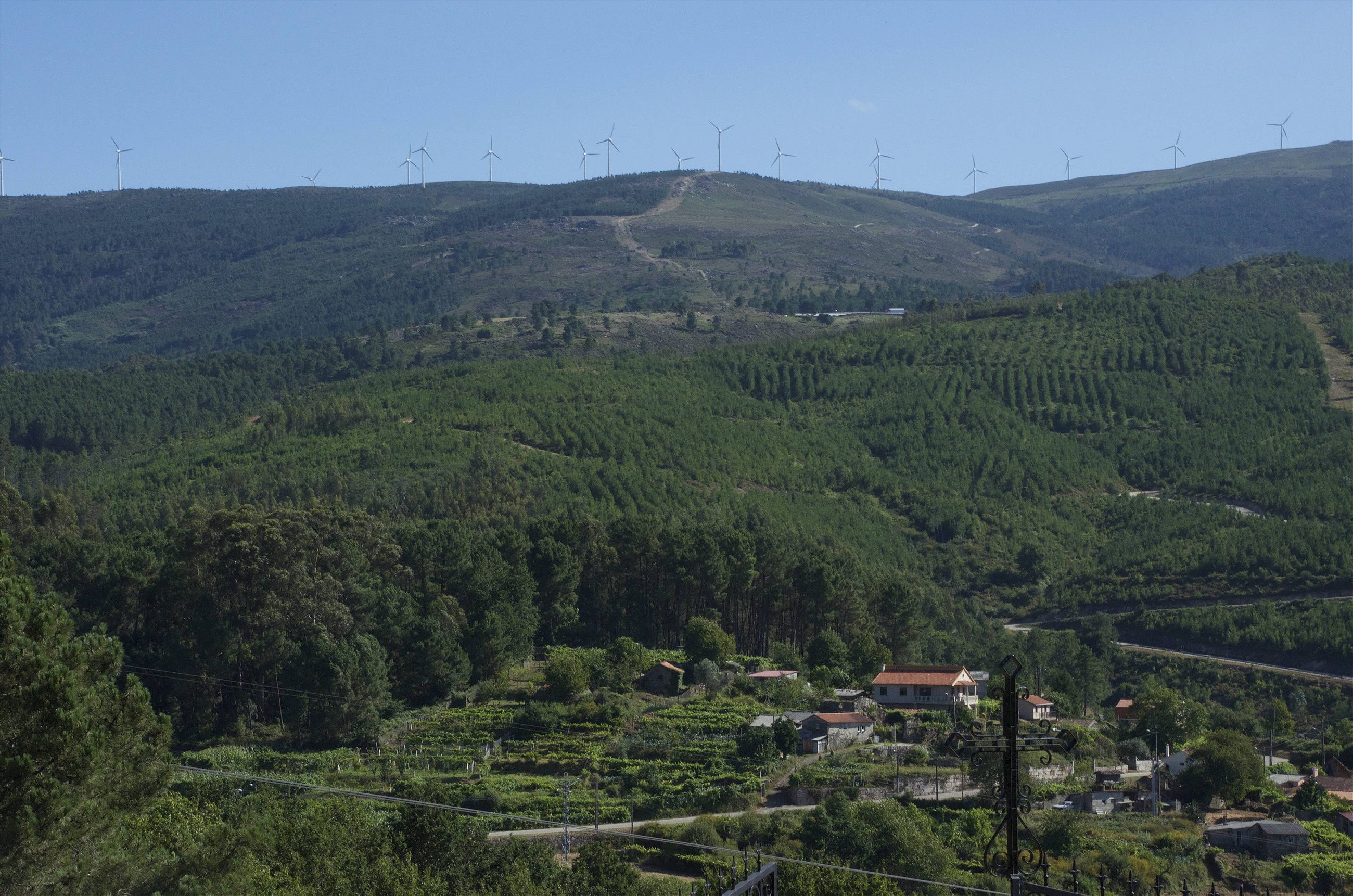
“It’s done as a promise,” Marcos Cames Cuña, a local taxi driver, tells me. “They swear to their patron saint, Santa Marta, that they will do the procession as thanks for, or in return for, their good health.” We are driving up the winding mountain roads of the town of As Neves on our way to the village of Santa Marta de Ribarteme, where this religious pilgrimage, or Romería in Spanish, is held. Marcos says that for the local people, and indeed, for all those that come from different parts of Spain to take part, the Romería de Santa Marta de Ribarteme is a deeply spiritual pilgrimage, “something that is taken very seriously, and is far removed from the strange spectacle that many tourists come expecting to see.” Scrunched up over the steering wheel, half racing driver, half nervous octogenarian, he responds to my questions in musical salivary mumbles, his native Galician accent thickly slathered onto his Castilian. “The attendees show their gratitude in a variety of ways,” he continues. “Some give money, some make the pilgrimage on their knees, some offer exvotos [crude sculptures of body parts that signify a miraculously healed affliction or the area of an ailment needing to be healed], others wear habitos [traditional procession garments that look like wedding veils] or,” he pauses, as if savouring the thought, “some get inside a coffin and process through the streets as part of an enormous public funeral of the living.”
Marcos drops me off at the foot of what appears to be a collection of sleepy farmhouses and vertiginous vineyards perched high up in the valley. “This is Santa Marta,” he indicates in a sweeping arm movement. “It all takes place here.” As Marcos leaves I notice a bar about 10 meters from where I’m standing, “Amigos da Rivera da Temes”, Friends of the River Temes. There, a local man is already feasting on a hearty breakfast of octopus and white wine. His protruding brow hangs heavily over his eyes as he chews hard at the fibrous tentacles. He mutters to himself between slurps of wine and puffs of a cigarette, seemingly enjoying his own company. Hunched up by the beating sun and his own old age, he clings tightly to the rosary beads in his right hand.
Above me on a narrow road that reaches up onto a wooded plateau there are a series of stalls. These stalls are manned by itinerant vendors from Ecuador and Colombia whose lilting mercantile petitions are soft against a background chatter of hawking Spanish consonants. Their merchandise however, is not as enticing as their entreaties: mostly cheap toys, power drills and other worldly trinkets. Beyond this is a small, austere church, La Iglesia de San Jose (Saint Joseph). More the size of a chapel, it clings to the edge of a sharp slope in the centre of the village. Its only bell tower stretches up into the sky like an ecclesiastical exclamation mark. From its two doors people stream out in fast, orderly lines. Some are lachrymose, others are simply solemn, but all seem focused by their devotion.
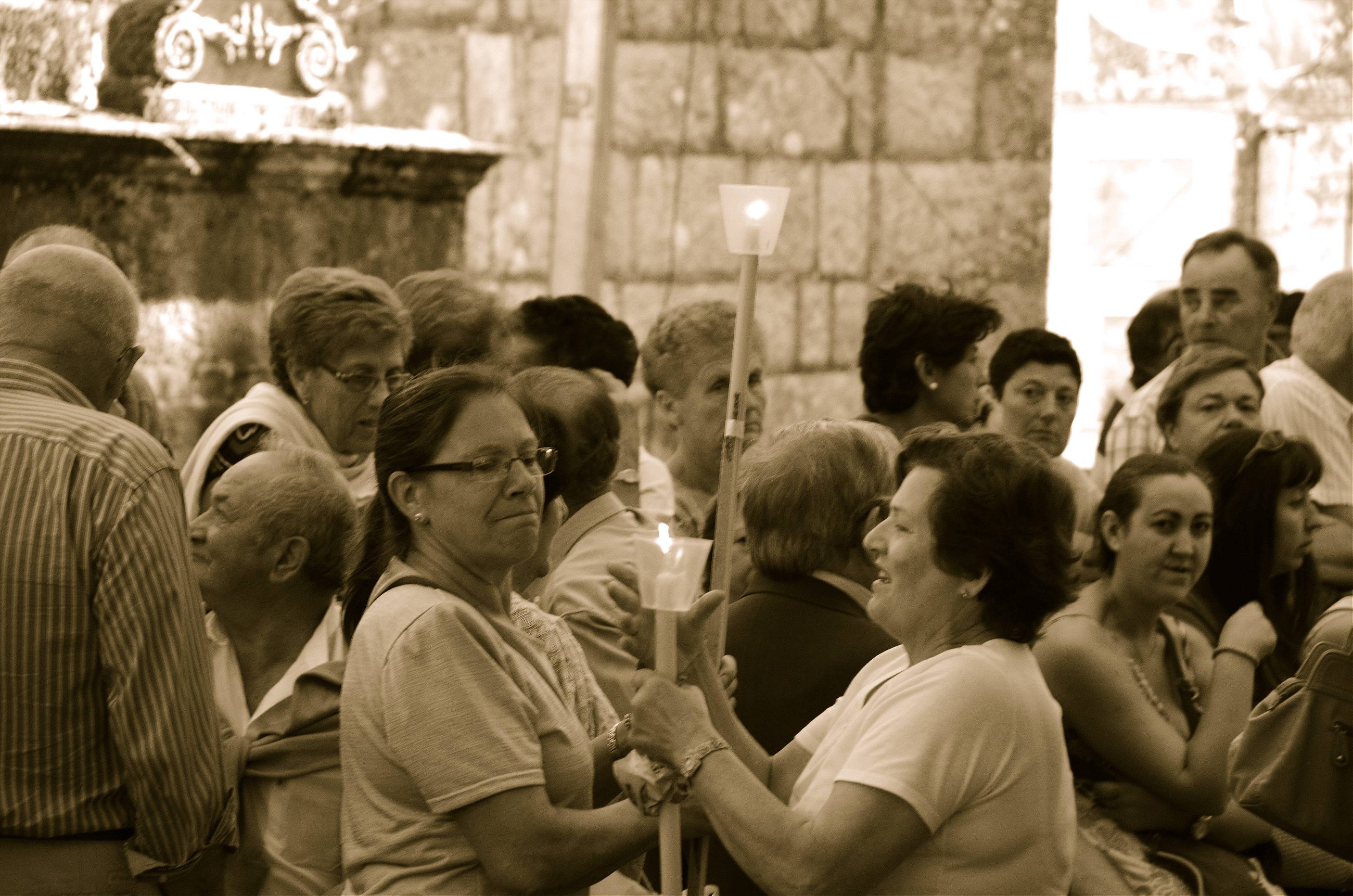
At the church’s right-hand side, there are some two thousand people lingering under a large, lop-sided marquee. It’s 9am and those present are attending an outdoor morning mass. Incense hangs in the air, mixed in with heavy clouds of equally pungent cologne. Women gaggle, gossip and giggle, whilst men grunt affectionately at one another in the morning sunshine. Many in the greater crowd are holding long slim yellow candles, each about 7ft tall, that look vulnerable to any act beyond extreme caution. These candles, like the exvotos piled up on tables everywhere, are offerings to the festival’s patron saint and are guarded obsessively by all those who have one. From an aged P.A. system comes the soothing voice of the priest, who administers long passages of the bible as spiritual anaesthetic. The crowds responds as if under hypnosis—reciting unconsciously, moving involuntarily and rising in unison to an eerie crescendo at the end of the Lord’s Prayer. I notice how rehearsed the ceremony seems, how precisely and mechanically the congregation goes about its worship; as if what I was witnessing were some cathartic factory gilded in clerical gold and perfumed with priestly incense.

The inside of the church is quite different from its hoary exterior—all fresh paint and shiny stonework. “There was a fire here in 1939 that burned the interior leaving only the walls standing—they had to restore it as a result,” wheezes Juan, an elderly local and regular attendee of the Romería. Towards the back end of the nave sits the Romería’s patron saint, Saint Martha. Looming high on a pedestal, Martha adopts the pious pose of the Catholic idol; a serene, vacant gaze, upward glancing to God. “Martha’s strong belief in Jesus and the beholding of her Brother Lazarus’s resurrection is why many locals believe that she has the power to heal the sick,” says Alfonso Besada Paraje, the local priest, “that’s why worship of her first started here.”
Although there is no doubt that many of the people here believe deeply in Saint Marta´s restorative powers, such a belief alone cannot explain the origin of the event itself. So when did this pilgrimage begin? And from where did it originate? No one knows for certain. Some say it started as far back as the 12th century, despite the first written reference to the pilgrimage dating to around 1700. Of its origin, locals argue that it was an attempt by the Catholic Church to adapt its dogma to the deeply ingrained pagan rites of the Galician region.

However, Carlos Hernández, a Spanish sociologist who has written about the Romería, found another, more practical reason. Whilst researching the event last year he was told by one local that the pilgrimage all began because people had no death insurance. When friends or family saw that a loved one was close to death they would buy a coffin in preparation. However if, for divine intervention, that fateful moment did not arrive, that once-sick loved one would then have to embark on a pilgrimage, with the coffin, to the church. There he or she would give thanks to Saint Martha for the miracle and donate the coffin to those who could not afford their own burial. Although this claim is somewhat speculative, it does fit into the 15th century Spanish notion of “dying well”. “Dying well”, as Allyson Poska writes in her essay Matters of Life and Death in Galicia, “exhorted the dying to make all the necessary preparations for a brief stay in purgatory and quick ascent to heaven.” These preparations would have included the delivery of last rites to a priest and the organisation of all those things pertaining to the person’s funeral, which one assumes would have included the purchase of a coffin.
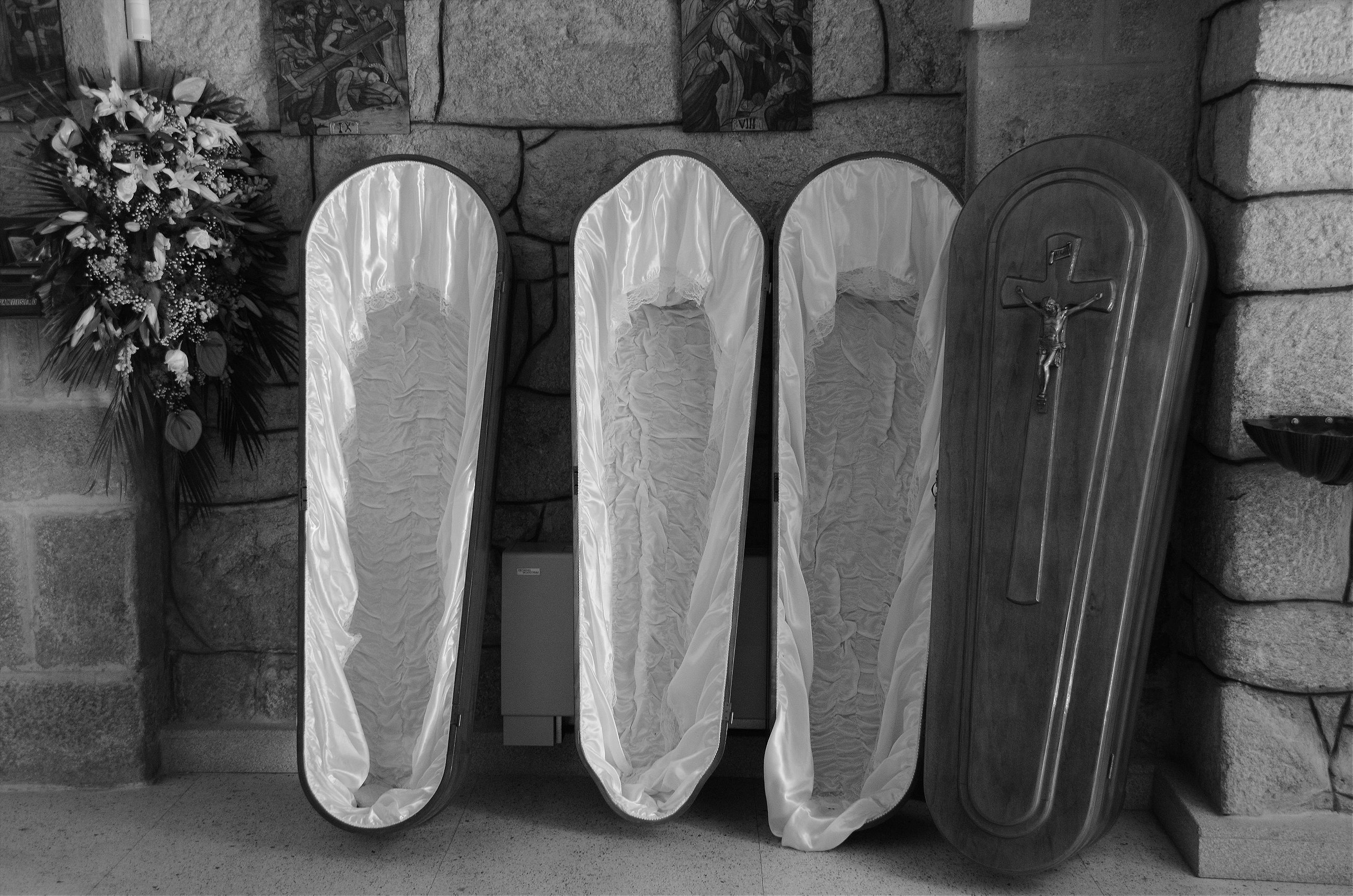
People clamor for prime position around their patron, some stretching out in adulation, others lurching with despair. There are people that look ill, some noticeably sick and others just sweaty from the heat of the midday sun. People enter wearing habitos, carrying offerings of wax breasts and wax heads, and dropping small fortunes into the church’s collection box. One woman, in her attempts to touch the idol’s body with her tissue, keeps bashing the heads of an irritated group in front of her—this woman is quickly shooed away. Those who have touched the statue begin vigorously wiping their blessed tissue over their face, neck and hands; an instantaneous relief captivating each of their bodies in turn. This is done, as one of those aforementioned devotees tells me, so that the individual might take, in return for their offering, a bit of the saint’s power to heal themselves or their loved one.
At the front of the nave stand four coffins; three are open, one is closed. “The coffin can be carried with a person inside or with no one inside. If there is no one being carried, then the coffin will travel with its top on,” says 21-year-old Marta Rodríguez, the sacristan of the church, “the coffins are always rented and people pay for them what they can,” she adds. Marta is the daughter of the local undertaker and has been performing a key organizational role in the Romería for over 10 years. “I am in charge of the coffins: of making sure that they are ready, of informing those helping to carry them, usually family and/or friends, how they should be carried.” The coffins stand in deathly luxury, their soft ruched fabric and highly polished hardwood the pinnacle of superfluous comfort. To the locals these long caskets are no more unusual than the plethora of crucifixes that populate the church, but to the gawking tourists and news crews, they create a buzz of incredulity and astonishment.
The Guardian newspaper declared the Romería the second strangest festival in the world
As I make my way to leave the church I ask Marta what she thought when she first saw the Romería all those years ago, “My first thought was, what a great belief people have and that even in difficult situations they are capable of making such big promises to the Virgin,” she answers, adding, “it is not the paranormal or medieval stupidity that some tourists come to see.” Indeed, it seems that international perception of the Romería is a difficult subject to unpack. On the one hand, many, including Karina Domínguez, are “very proud” to host their curious guests, on the other, the distortion of the event by the foreign press can and has crossed the line. “The Romería is about many things: the pilgrimage to the church, attendance of the Saint’s mass, doing penance. It is a serene experience,” says Father Alfonso Paraje, “it is not a folkloric spectacular or the strange macabre procession the foreign journalists make it out to be.” Indeed, when the Guardian newspaper declared the Romería to be the second strangest festival in the world, in 2008, it seemed to bring a lot of unwanted attention.
Carlos Hernández tells me that when a team from National Geographic came to film in Santa Marta last year, instead of respecting and documenting the local customs, “they ridiculed the Romería, laughing at the traditions and even at the food.” This struck a nerve with many local residents and damaged their relationship with the visiting media outlets. Father Paraje calls it depressing: “The way that the press has reported the event has made the people of our region look ignorant, like people that, in spite of this age of great social evolution, live as if they were from the Middle Ages. And this simply isn´t true.”
I make my way out of the church and to a large white tent further up the hill. There, in what looks like a large car park, a brass band churns out a rendition of the paso doble, a song made famous for being the prelude to the much-contested bullfight. To the right of the bandstand are five large tables full of people indulging in an early lunch. These tables stretch some 30 meters in length and are surrounded on all sides by bars, food vendors and haggard waiters spilling overflowing gin and tonics on the laps of disgruntled diners. Behind these tables sit two enormous bubbling vats of evil-smelling octopus. The chef, a rather portly and severe woman, hooks each whole octopus out of the frothing water with a sharp iron rod and flings it across to her assistant. The assistant, a diffident looking man, winces and whines from the burning heat of the flesh. Then, and in spite of his grimaces and dramatic gesticulations, he skilfully snips its tentacles into neat fleshy discs. Added to these discs is a generous handful of rock salt, a prolonged glug of olive oil and three flicks of paprika—the resulting creation is pulpo a la gallega, or as it is known in Galicia, polbo á feira. Wolf it down with a bottle of albariño and you are eating the region’s most famous dish.
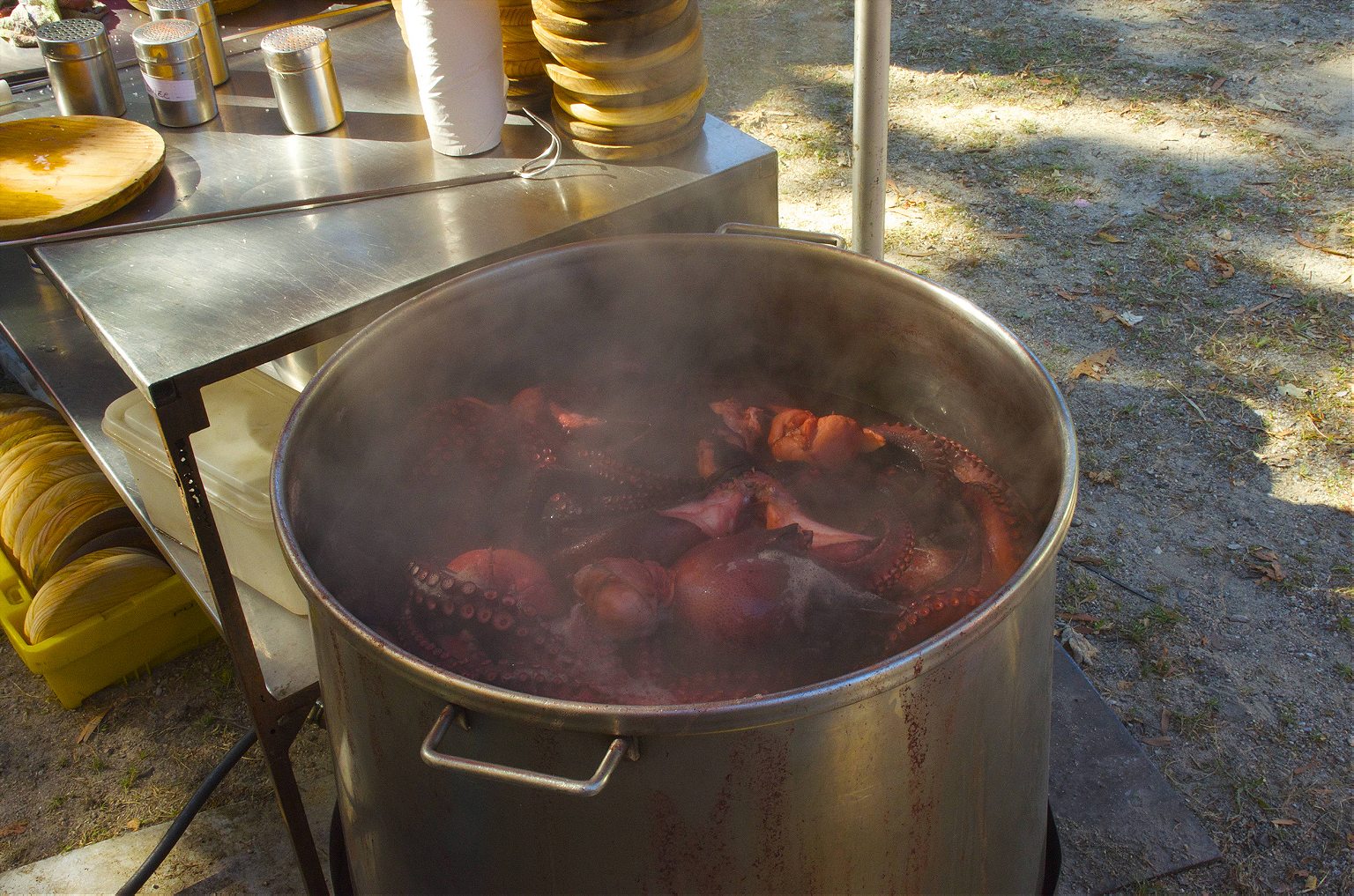
“This is another important part of the day,” Carmen, a native Galician, tells me, “We might concentrate on death a lot, but we also know how to eat and celebrate well.” Dressed all in black and in the traditional dress of mourning, Carmen cuts a very Iberian figure. She is small and elderly, but not fragile and when she answers my questions she speaks so quietly she seems to inhale her words. “I’m from a nearby village and I’ve come with my family this year to watch the Romería and eat good octopus,” she says. Father Paraje confirms this as a very common attitude of local people, “One of the main elements of the Romería is to eat octopus and other local foods and to enjoy the music and dance of the event as a whole.” In Galicia it seems to eat well is to live well and to live well is one of the best ways in which to celebrate life and to be thankful for health.
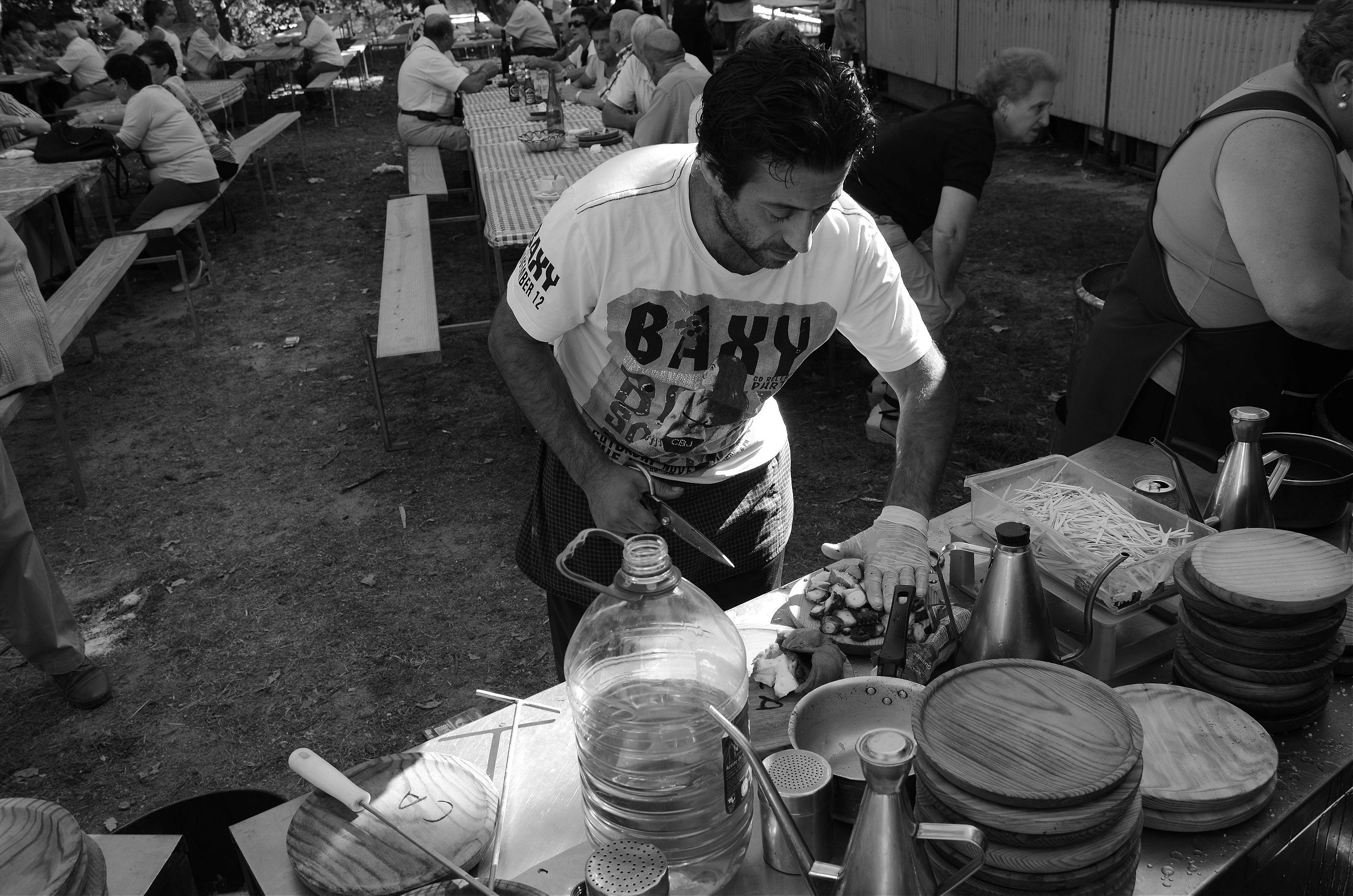
“La misa solemne está terminando,” a man shouts up to his friends from the grassy knoll that sits below the large eating tent; the “solemn mass”, the last of the morning´s sermons, is ending and the departure of the coffins from the church is imminent. Rushing back down the slope I secure my place among a barrage of cameras and correspondents. The band from the car park strikes up some gloomy marching music and the procession starts. First to exit the church are the idols of San Benito and La Virgin del Carmen, the patron saints of the village’s two other yearly festivals. People murmur and crane their necks in anticipation, an old man by the church gate begins to weep and thousands of devotees everywhere ready themselves for the beginning of the walk, Saint Martha exits the church next, her head bobbing and dipping as a result of the unsynchronised walks of her carriers; she still strikes her reverent pose. Now, everyone begins to push into position; straining, leaning and lunging so that they might optimise their views of the parade. More people begin to weep. Camera shutters purr.
The caskets are raised aloft by each of their own pallbearers and lurched out, one by one, into the implacable midday sun. The first coffin is closed, with no one inside, while the remaining three coffins carry people and are open to the elements. One carries a spindly, middle-aged man, the other, an eerily still elderly woman, and in the last is Karina, clad in sunglasses and covering her face with a green fan. The heat is intense and for those devotees in coffins it must be unbearable. But then again, nobody can remember the weather ever being any different—the sun has always shone during the Romería, no matter the weather beforehand. “Last year, before the beginning of the procession, it was very cloudy, as if it were going to rain,” says Karina Domínguez, “but as soon as the procession left the church the sun came out, and it stayed out for the duration of the Romería. After it all finished, however, it became cloudy again.”

The procession makes its way slowly out of the church grounds. The band’s meter dictates the leisurely pace and the coffins negotiate their way through the crowd and up onto the roadside. There they are met by yet more gaping mouths and camera flashes, a heaving sea off inquisitiveness into which the coffins seem perpetually on the verge of capsizing. Below the crashing din of the band some members of the crowd begin to hum and susurrate the song of the Romería, “Virgin Santa Marta, star of the North, we bring you those who saw death,” while others hang their heads respectfully, in concentrated devotion to their patron and to God. However, as the procession creeps evermore forward these sounds and sights begin to disappear, until not mo more camera-flashes can be seen.
When the procession returns after having completed its circuit the slightly sun-addled participants step gingerly out of their coffins and, trying to avoid unwanted photographs and interviews, they disappear into nearby houses or cars and into the custody of their own prayers and promises. “No words can describe what it is like to be carried in a coffin alive,” offers Karina enthusiastically. “It makes you remember all your struggles and why exactly you wanted to be there in the first place… and when you finally get out you feel good about yourself,” she says resolutely, “you feel liberated and glad to be alive.”

The Galicians have a peculiar relationship with death. In Galicia death is far more integrated into everyday life; it is more openly celebrated and its sorrow shared by more people. Carlos Hernández tells me that he once found himself at a funeral in a Galician village where both the church and the cemetery were packed with people. “I thought someone famous had died,” he says. However, it was just a local from the village. “In Galicia everyone goes to the funeral of everyone else,” he continues, “and in these villages the family of the deceased will often provide free transport so that nobody in the village is without a means of getting there.” But not only is death more openly celebrated here, it also treated quite superstitiously. Galician culture is full of references to witches and wandering spirits that, particularly in the villages, still play a role in day to day life. As one of the vendors of exvotos during the Romería said to me, “We’re as religious as we are superstitious sometimes.” And it is for its curious mix of Catholicism and superstition that the Romería de Santa Marta can be said to be uniquely Galician. Carlos says, “although you can find fiestas similar to this Romería in Galicia it would be unthinkable to encounter such a phenomenon in another part of Spain.” Death is an enemy the Galicians keep close. And as a result, nowhere in Spain is death so life-affirming as it is in Galicia.
